| (insert your NIE or newspaper logo here) |
Weekly Online LessonOnline Lesson ArchiveGrade Level: 6-12
|
Twister Season Springs into Action
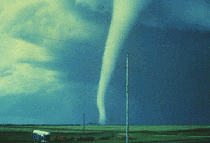 Spring
showers help things grow, but they can also
destroy and kill.
Spring
showers help things grow, but they can also
destroy and kill.
That was the reminder on Saturday, March 11, 2006, as a severe storm system engulfed a stretch from the southern Plains to the Ohio Valley. The storm released torrential rains, softball-sized hailstones, and tornadoes that cleared a 20-mile path across southern Missouri and southern Illinois.
About 1,200 tornadoes occur in the United States every year, causing about 65 fatalities, 1,500 injuries, and millions of dollars in damage nationwide. Although many tornadoes occur as late as November, spring's twisters—from late March and into June—are typically the fiercest. Even in the absence of tornadoes, severe storms do a fair amount of damage, causing rapid erosion and flash floods.
Although there's only so much humans can do when facing nature's powerful forces, scientists have learned a lot over the years about predicting when and where severe weather will happen. Plus, residents are getting better at protecting themselves from nature's devastating blows.
In this week's lesson, you'll discover how weather conditions can give rise to severe storms and tornadoes. You'll also learn about the different types of severe weather, how you can track conditions in your own neighborhood, and how to prepare for the worst.
The Science behind the Headlines
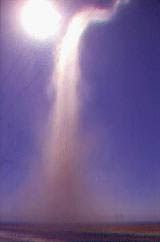 Begin
your lesson by heading off to WW2010 (the
Weather World 2010 Project) at the University of Illinois, where they've got a cool online meteorology guide on Severe Storms. As you browse through this guide,
you can click any underlined word for its definition. Just click your browser's BACK button to return to where you left off.
Begin
your lesson by heading off to WW2010 (the
Weather World 2010 Project) at the University of Illinois, where they've got a cool online meteorology guide on Severe Storms. As you browse through this guide,
you can click any underlined word for its definition. Just click your browser's BACK button to return to where you left off.
Tornadoes are just one type of severe storm, so continue by reading Flash Floods and Hail in the Dangers of Thunderstorms section. Using the NEXT arrows at the bottom, browse the other pages and read about Outflow, Downbursts and Tornadoes.
In what ways do urban areas escalate flood risks? How do "straight-line" winds originate? What's a gust front? What's the difference between a microburst and a macroburst? How often do weak, strong and violent tornadoes occur? How do well-built homes compare for surviving weak vs. strong hits?
As you discovered in the Dangers section, tornadoes are rooted in thunderstorm activity. The next section delves deeper into the nature of severe storms, beginning with Types of Thunderstorms. Here, you'll learn about the thunderstorm spectrum, from single cell storms to supercells. Which ones are categorized as "severe"? What's the difference between a multicell cluster and a multicell line? Can you describe some of the characteristic features of each type of storm?
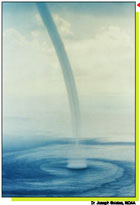 Let's break down these storms into even smaller pieces by looking at the Components of Thunderstorms. As you move through these sections—Updrafts/Downdrafts, Wind Shear, Outflow Phenomena and Wall Clouds—you'll read about how scientists watch and record each component's characteristics. How does understanding the behavior of each component help scientists predict if a tornado might develop?
Let's break down these storms into even smaller pieces by looking at the Components of Thunderstorms. As you move through these sections—Updrafts/Downdrafts, Wind Shear, Outflow Phenomena and Wall Clouds—you'll read about how scientists watch and record each component's characteristics. How does understanding the behavior of each component help scientists predict if a tornado might develop?
Now you get to spend time in the eye of the storm—that is, in the Tornadoes section. Here, the Useful Diagrams, Low-level Flow, Evolution and Cyclic Storms pages help illustrate how the weather conditions and storm components come together in the "big picture." If you have time, browse the Modeling section in the guide, which shows how using computer-modeling helps experts understand supercell behavior.
So how do weather experts use these different types of data and collected observations to piece a storm puzzle together and make predictions? What are the limits of their methods and tools? Do any storm components seem to have stronger influences on tornado formation than others?
Preparing for the Storm
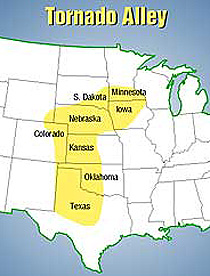 Now
let's explore how severe storms and tornadoes
can affect people's lives, and how everyone can best
prepare for the worst-case scenario.
Now
let's explore how severe storms and tornadoes
can affect people's lives, and how everyone can best
prepare for the worst-case scenario.
The National Oceanic and Atmospheric Administration has a great Tornadoes site for severe weather updates, statistics and safety suggestions.
Go to the Nature's Most Violent Storms page, and scroll through the overview on tornadoes to the Frequency of Tornadoes section. Check out the Months of Peak Tornado Occurrence for your state. Note that a few states have peaks in both the spring and fall.
Also, review the graphs titled, United States Totals, 1961-1993 and U.S. Reported Tornadoes and Average Deaths per Year.
Keep scrolling down the page, reading Stay Informed about the Storm, What to Listen For..., Environmental Cues and Tornado Safety, making sure you know how to help create or participate in a Family Disaster Plan and at School. What do you know about tornadoes that can help you make the best decisions for keeping safe if faced with that threat?
But, of course, tornadoes aren't the only worry. Think about what happens to local and regional water systems when the area gets a lot of rain at once. What happens to water levels and where does the water go?
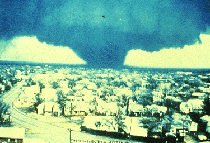 While you're waiting for the next storm to hit, you can check out the Storm Reports and browse around the Storm Prediction Center.
While you're waiting for the next storm to hit, you can check out the Storm Reports and browse around the Storm Prediction Center.
From here you can look at Today's Storm Report, Yesterday's Storm Report or look at the Storm report data for past days by typing in a specific date. Each report shows occurrences of tornadoes, wind damage and large hail, along with individual listings of each event, including its location, who reported it and if there was any property damage or personal injury.
Also browse through the Statistical data for this year, checking out the Monthly Tornado Statistics or Deadly Tornadoes in 2003, or browse through the Statistical data for previous years. Do tornado deaths ever occur in some of the same regions year after year? If so or if not, why do you think that's the case?
Can you find any tornado deaths that have occurred in your state or in a neighboring state since 1997? If the closest state where tornadoes have killed people is two or more states away, can you explain why these events are so rare in your part of the country?
Newspaper Activities
Over the next couple of weeks or more, keep a weather journal and check the daily weather forecast in Targetnewspaper. Also, look for news articles that highlight any severe weather events in your state. Record the newspaper's weather predictions in your journal, and once or twice a day describe your first-hand observations of weather conditions. Be as detailed as possible. For easy reference during the project, post a map in your classroom illustrating your regional watershed system. Use your newspaper or other resources as needed to track measures in rainfall, stream flows or reservoir levels. Note in your journal and on the regional map any related events that may occur, such as areas hit by flash floods, reservoir releases, etc.
Create charts and graphs illustrating the changes in weather and water patterns over time. Add any other details, like if there were any injuries or property damage. Explain any patterns you notice, as well as any discrepancies. How well did the weather predictions match reality? In what ways did the weather patterns influence human activities?
© Copyright 2006
Learners Online, Inc.
